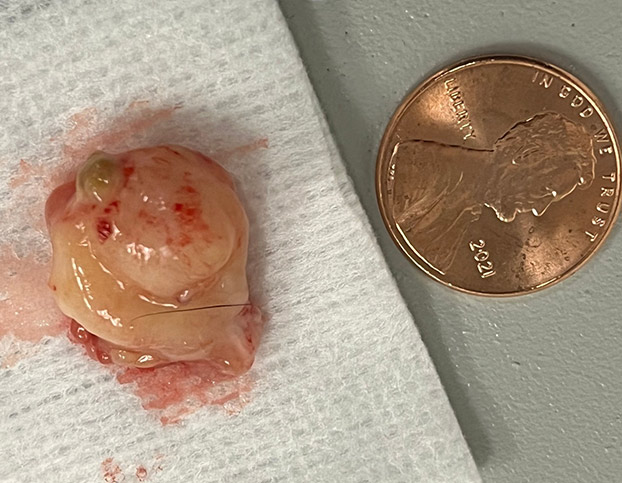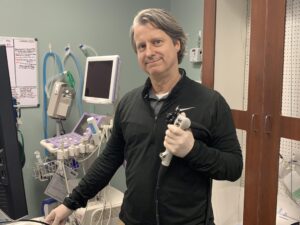Although there are variety of causes of sneezing, runny nose and nasal discharge in cats, one cause that should always be considered, especially in young cats, are nasopharyngeal polyps.
What are nasopharyngeal polyps?
Nasopharyngeal polyps are benign (non-malignant, non-cancerous) growths (masses) that occur in the nasopharynx (the area above the soft palate), and which can also involve the eustachian tube, middle ear and even the ear canal. They originate in the tissue lining the tympanic cavity (middle ear) and can growth “up” through the ear drum and into the ear canal, or “down” following the eustachian tube and into the nasopharynx
Often the polyps resemble a little “punching bag” with a pink, smooth, glistening round fleshy portion attached to a thin stalk. NPPs can grow to be as large as 1” in diameter


Successfully removed nasopharyngeal polyp
The exact cause of nasopharyngeal polyps is unknown, but because they are most common in kittens and very young cats, a congenital cause is thought possible. Multiple littermates can develop nasopharyngeal polyps lending some possibility that genetics may play a role. Young cats are also at higher risk for developing upper respiratory infections (URIs) so an infectious cause has been theorized, although, to date no specific organism has been isolated. Nasopharyngeal polyps are not considered contagious.
What symptoms do nasopharyngeal polyps cause?
The symptoms are non-specific and mimic other upper respiratory diseases such as upper respiratory infections (URIs), inhaled foreign material and even cancer. Symptoms can include frequent sneezing, nasal discharge of vary consistency and color, loud breathing (snoring), mouth-breathing, runny eyes, and even trouble swallowing. Some cats may have ear-related symptoms, such as head-shaking and rubbing or pawing the ear.
How are nasopharyngeal polyps diagnosed?
Nasopharyngeal polyps are best diagnosed with direct visualization of the polyp through the oral cavity. If a patient primarily has ear-related symptoms, direct visualization of the ear canal with an otoscope can identify these.
In our practice, we primarily diagnose nasopharyngeal polyps in the, as the name implies, nasopharynx with the use of endoscopy and specifically, rhinoscopy. Sometimes these polyps are large enough that they can easily be visualized simply by looking in the mouth (anesthesia is required), and gently retracting the soft palate to allow the polyp to hang down into the oral cavity.
How are nasopharyngeal polyps treated?
Believe it or not, most polyps within the nasopharynx can be removed simply with gentle, steady traction (pulling) with forceps until it comes out. This is performed with pain control and while under anesthesia.
When the polyp is involving the middle ear, there are various surgical procedures that can be used to access that portion of the ear to remove the polyp.

Nasopharyngeal polyp removed with forceps
Are there complications with removing nasopharyngeal polyps?
Possible complications that could occur can include neurologic abnormalities (e.g. Horner’s syndrome) and ear inflammation or infection — these can be treated and sometimes resolve on their own. We find that the complication rate is very low, and that the benefits of improving your kitten’s breathing well outweighs any risks that could occur while removing them.
What is the prognosis after removal?
It is important to know that after removal of a nasopharyngeal polyp, they can “grow back”. Studies have reported that a recurrence rate of up to 50% is possible. The polyps that occur in the middle ear have a higher likelihood of recurring since it is more difficult to remove the entire polyp (think: leaving the roots of a weed).
Your pet’s safety and your confidence is our priority
In summary, nasopharyngeal polyps are a common cause of upper respiratory symptoms, especially in kittens and young cats. These are benign and can typically be easily and safely removed as an outpatient procedure. Although there are possible complications, the improvement in your kitten’s quality of life after removing the polyp far outweigh the risks of the procedure.
We understand that you worry about your furry family member, and we will spend as much time discussing all aspects of the procedure with you prior to the procedure to ensure that you are comfortable and confident. Please contact us if you have questions about nasopharyngeal polyps.

Author:
James Woods DVM, MS, DACVIM (SAIM)
Ph: (912) 721-6410
Contact Us
